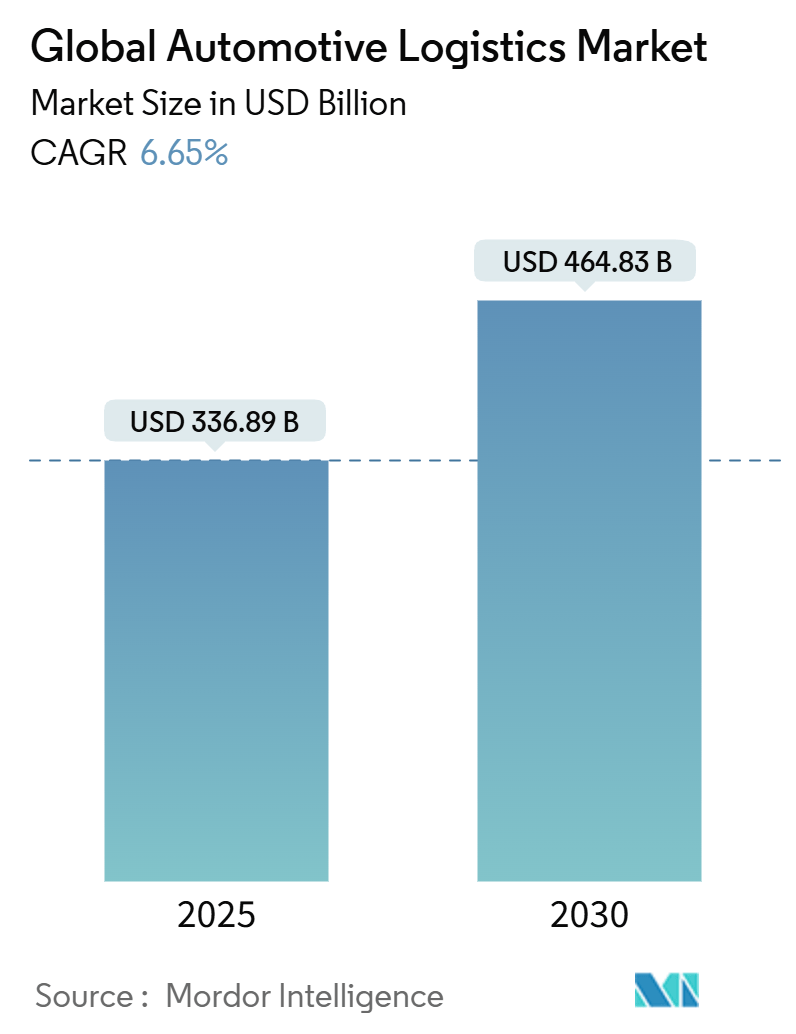
| Study Period | 2019 - 2030 |
| Market Size (2025) | USD 336.89 Billion |
| Market Size (2030) | USD 464.83 Billion |
| CAGR (2025 - 2030) | 6.65 % |
| Fastest Growing Market | Asia-Pacific |
| Largest Market | Asia-Pacific |
| Market Concentration | Low |
Major Players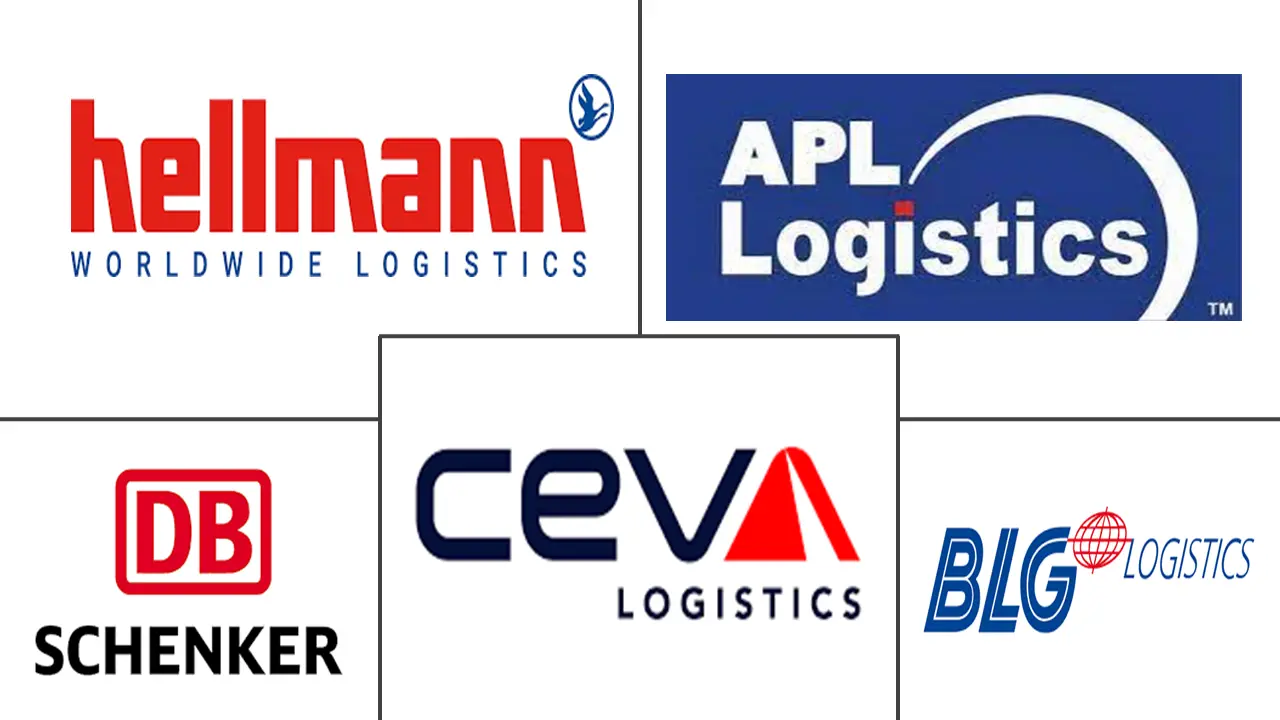
*Disclaimer: Major Players sorted in no particular order |
Global Automotive Logistics Market Analysis
The Global Automotive Logistics Market size is estimated at USD 336.89 billion in 2025, and is expected to reach USD 464.83 billion by 2030, at a CAGR of 6.65% during the forecast period (2025-2030).
The automotive logistics landscape is experiencing unprecedented transformation driven by shifting production patterns and evolving trade dynamics. China has emerged as a dominant force in global automotive exports, shipping 4.91 million vehicles in 2023, marking a substantial 57.9% increase from the previous year. This shift has prompted major automotive logistics providers to adapt their networks and capabilities, with companies like COSCO Shipping launching specialized digital supply chain platforms for the automotive industry. The integration of advanced technologies, including IoT, Big Data, and AI, is revolutionizing automotive supply chain visibility and operational efficiency across the sector.
The electric vehicle revolution is reshaping traditional logistics frameworks and creating new demands for specialized handling and transportation solutions. In 2023, global deliveries of new battery electric vehicles (BEV) and plug-in hybrids (PHEV) reached 14.2 million units, representing a 35% increase year-over-year. This growth has catalyzed significant investments in dedicated EV logistics infrastructure, exemplified by Maersk's development of a 20,000-square-meter logistics center near Hanover specifically designed for electric car batteries and components, scheduled for completion in 2024.
Major automotive manufacturers are making substantial investments in automotive logistics infrastructure to support their expansion strategies. Stellantis announced a record EUR 5.6 billion investment plan for South America spanning 2025-2030, while BYD revealed plans for its first European passenger car factory in Hungary. These developments are driving automotive logistics companies to enhance their capabilities and geographic coverage, with companies like CEVA Logistics extending their partnerships with premium manufacturers such as Ferrari to provide comprehensive automotive logistics services during Grand Prix events and GT races.
The industry is witnessing a significant shift toward sustainable and digitalized automotive logistics solutions, particularly in emerging markets. In India, where the automotive sector contributes 7.1% to the GDP and logistics influences over 13% of GDP, companies are increasingly adopting green logistics practices and digital solutions. This transformation is evident in the implementation of unified logistics interface platforms and the development of specialized electric vehicle logistics networks. Ford's establishment of a new 42,000 sq.m parts distribution center in Dubai World Central economic zone in 2024, equipped with cutting-edge technology, exemplifies the industry's move toward more sophisticated and efficient logistics solutions.
Global Automotive Logistics Market Trends
Growing Automotive Production and Sales
The global automotive industry has witnessed substantial growth in production volumes, creating increased demand for sophisticated automotive logistics solutions. In 2023, China's auto exports reached an unprecedented 4.91 million vehicles, marking a 57.9% surge from the previous year, with new energy vehicle (NEV) exports rising by 77.6% to surpass 1.2 million units. This surge in production and cross-border movement has necessitated the development of more efficient and specialized automotive logistics networks, including new shipping routes, enhanced port facilities, and specialized handling equipment for various vehicle types.
Major automotive manufacturers are expanding their production capabilities through significant investments, further driving the need for comprehensive logistics solutions for the automotive industry. For instance, Stellantis announced a record EUR 5.6 billion investment plan for South America from 2025 to 2030, while BYD signed an agreement to establish its first passenger car factory in Europe. These expansions require robust logistics networks capable of handling both incoming components and outbound finished vehicles, creating opportunities for automotive logistics providers to develop specialized services and infrastructure to support the growing automotive manufacturing ecosystem.
Rising Electric Vehicle Adoption
The accelerating transition toward electric vehicles has created new demands for specialized automotive logistics solutions. In 2023, global electric vehicle sales reached 14.2 million units of new battery electric vehicles (BEV) and plug-in hybrids (PHEV), representing a 35% increase year-over-year. This shift requires logistics providers to develop new capabilities for handling EV-specific components, particularly batteries, which demand specialized storage conditions, handling procedures, and transportation requirements to ensure safety and compliance with international regulations.
The establishment of new EV manufacturing facilities worldwide has created additional complexity in automotive industry logistics operations. For example, Lucid Motors' first international manufacturing plant in Saudi Arabia, with a planned capacity of 155,000 vehicles annually, and VinFast's expansion into global markets demonstrate the need for specialized logistics solutions. These developments have prompted logistics providers to invest in new infrastructure, including temperature-controlled warehouses, specialized handling equipment, and enhanced safety protocols specifically designed for EV components and finished vehicles.
Technological Advancements in Logistics
The integration of advanced technologies is revolutionizing automotive logistics and supply chain operations, enhancing efficiency and transparency throughout the supply chain. In 2023, COSCO Shipping launched a digital supply chain platform for the automotive industry, incorporating Internet of Things (IoT), Big Data, Artificial Intelligence (AI), and 5G technologies to seamlessly connect all aspects of the shipping industry. This platform offers 310 digital supply chain products, including trailer services, warehousing, customs declaration, shipping, unpacking, and PDI testing, demonstrating the industry's move toward comprehensive digital solutions.
The adoption of blockchain technology, real-time tracking systems, and automated warehouse solutions has become increasingly prevalent in automotive supply chain companies. For instance, Al-Futtaim Logistics has implemented IoT-based yard management strategies, incorporating ultra-wide-band technology, data analytics, and connected vehicles to enhance operational efficiency. These technological implementations have enabled logistics providers to optimize routes, minimize idle hours, and provide customers with real-time visibility of their shipments, fundamentally transforming how automotive logistics operations are managed and executed.
Cross-Border Trade Expansion
The development of new trade routes and corridors has significantly impacted the automotive transportation industry. In 2023, CEVA Logistics launched new international road transport (TIR) routes along the China-Kyrgyzstan-Uzbekistan and China-Pakistan corridors, marking a significant expansion of automotive logistics capabilities. These new routes, combined with planned infrastructure developments such as the China-Kyrgyzstan-Uzbekistan Railway scheduled for completion in 2025, are creating more efficient pathways for automotive transportation and expanding market access for manufacturers and logistics providers.
The establishment of new logistics hubs and free trade zones has further facilitated cross-border automotive trade. For example, Jafza's roll-on, roll-off (RoRo) terminal, capable of handling up to 1 million car equivalent units (CEUs) and storing 27,000 CEUs within its quay-side yards, demonstrates the scale of infrastructure development supporting automotive logistics. Additionally, the development of new maritime routes and the expansion of port facilities have enhanced the industry's capacity to handle growing international automotive trade volumes, particularly in emerging markets where new manufacturing facilities are being established.
Segment Analysis: By Service
Transportation Segment in Global Automotive Logistics Market
The transportation segment dominates the global automotive logistics market, commanding approximately 64% market share in 2024. This segment's prominence is driven by the increasing cross-border trade of vehicles and automotive components, particularly between major manufacturing hubs and consumer markets. The growth in international trade, expansion of automotive manufacturing globally, and rise in free trade agreements between nations have significantly boosted transportation automotive logistics services. The segment has witnessed substantial technological advancements, including real-time tracking, RFID technology, and IoT-enabled devices, which have enhanced supply chain visibility and operational efficiency. Additionally, the increasing adoption of multimodal transportation solutions and the development of specialized vehicle carriers have further strengthened this segment's position in the market.
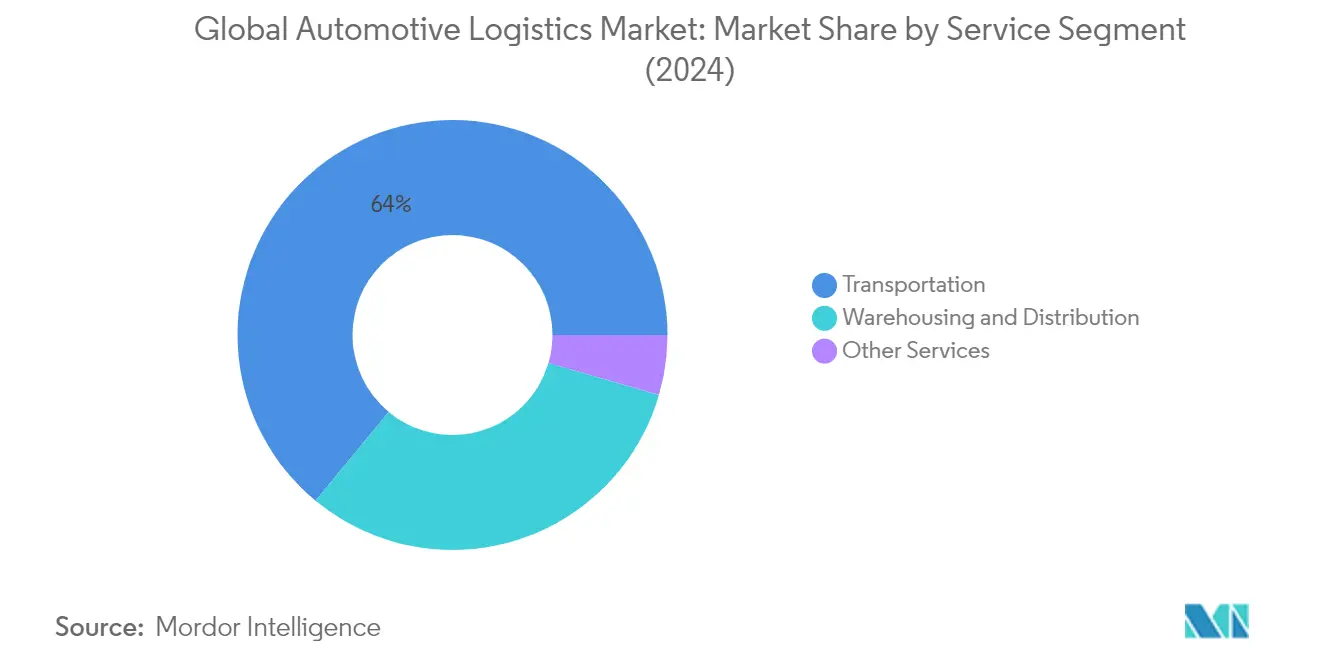
Warehousing, Distribution, and Inventory Management Segment in Global Automotive Logistics Market
The warehousing, distribution, and inventory management segment is experiencing robust growth, projected to expand at approximately 5% during 2024-2029. This growth is primarily driven by the increasing demand for sophisticated storage solutions and efficient inventory management systems in the automotive sector. The segment is witnessing significant transformation through the adoption of advanced technologies such as automated storage and retrieval systems (AS/RS), warehouse management systems (WMS), and artificial intelligence-driven inventory optimization tools. The rise of electric vehicles has created new requirements for specialized storage facilities, particularly for batteries and sensitive electronic components. Furthermore, the segment is seeing increased investment in strategic locations near manufacturing facilities and key markets, enabling just-in-time delivery capabilities and reducing overall automotive supply chain costs.
Remaining Segments in Automotive Logistics Market By Service
The other services segment in the automotive logistics market encompasses specialized offerings such as reverse logistics, packaging solutions, and value-added services. This segment plays a crucial role in supporting the automotive industry's evolving needs, particularly in areas such as aftermarket services and spare parts distribution. The increasing focus on sustainability has led to the development of eco-friendly packaging solutions and efficient reverse logistics systems for handling end-of-life vehicles and components. Value-added services, including quality inspection, assembly, and customization, have become increasingly important as automotive manufacturers seek to differentiate their offerings and meet specific market requirements. The segment also includes specialized services for handling electric vehicle components and batteries, reflecting the industry's shift towards electrification.
Segment Analysis: By Type
Finished Vehicle Segment in Global Automotive Logistics Market
The Finished Vehicle segment dominates the global automotive logistics market, commanding approximately 57% of the total market share in 2024. This segment's prominence is driven by the increasing global vehicle production and cross-border trade of completed vehicles. The segment encompasses comprehensive automotive logistics solutions for transporting finished vehicles from manufacturing plants to dealerships or end customers. The growth is particularly notable in emerging markets like China, which has become the world's largest vehicle exporter, and established markets like Europe and North America. The segment's strength is further reinforced by the rising demand for electric vehicles, with manufacturers requiring specialized logistics solutions for their finished EVs. Additionally, the segment benefits from the development of sophisticated vehicle handling facilities at ports and the implementation of advanced tracking and monitoring systems to ensure safe and efficient vehicle transportation.
Auto Components Segment in Global Automotive Logistics Market
The Auto Components segment is projected to experience the highest growth rate in the automotive logistics market during the forecast period 2024-2029, with an expected CAGR of approximately 6%. This accelerated growth is primarily attributed to the increasing complexity of global automotive supply chains and the rising demand for just-in-time delivery systems. The segment is witnessing significant transformation due to the growth of electric vehicle production, which requires specialized logistics solutions for battery components and other EV-specific parts. The expansion of automotive manufacturing facilities in emerging markets has created new opportunities for automotive logistics providers. Furthermore, the segment's growth is supported by the increasing adoption of digital technologies and automation in warehouse management, inventory tracking, and supply chain optimization. The trend toward vehicle electrification and the need for sophisticated logistics solutions for handling sensitive electronic components and batteries is expected to continue driving the segment's growth.
Global Automotive Logistics Market Geography Segment Analysis
Automotive Logistics Market in Asia-Pacific
The Asia-Pacific region represents a dominant force in the global automotive logistics landscape, driven by robust manufacturing capabilities and expanding automotive sectors across multiple countries. China leads the regional market with its massive production capacity and export operations, while Japan maintains its position as a key automotive manufacturing hub. India's rapidly evolving automotive sector and South Korea's technological advancements in the automotive industry contribute significantly to the region's dynamics. The region benefits from well-developed infrastructure, strategic port locations, and increasing adoption of advanced automotive logistics services.
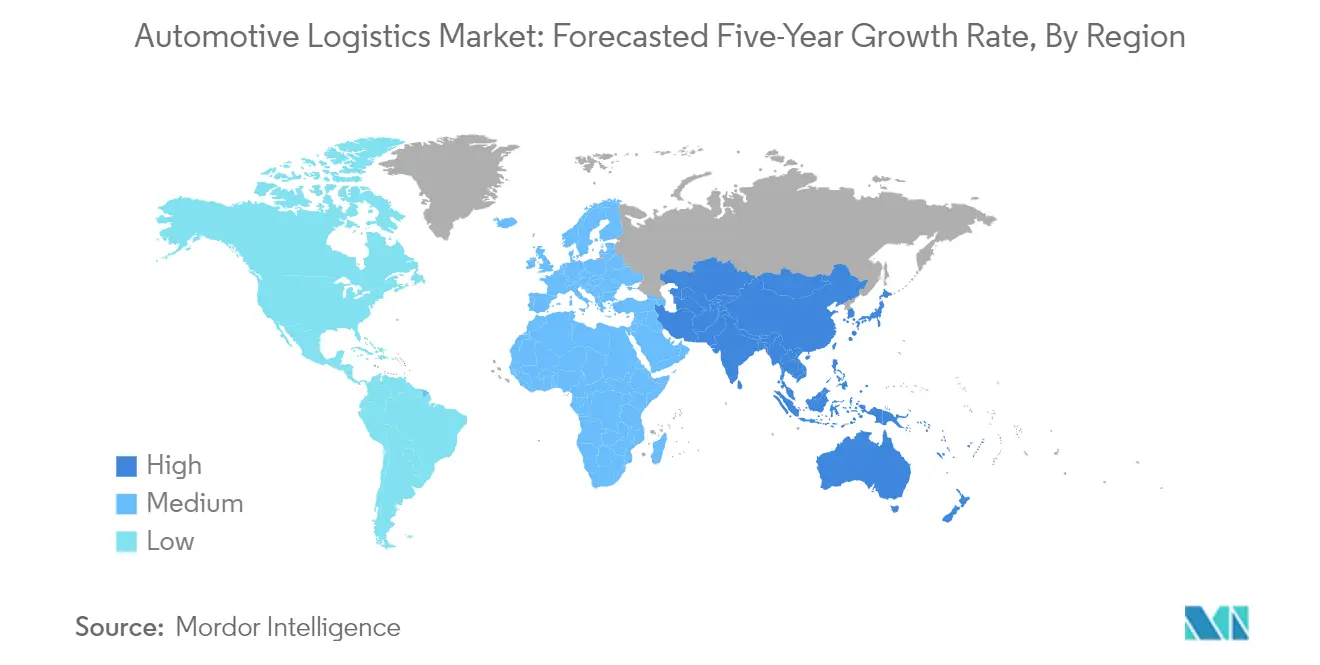
Automotive Logistics Market in China
China stands as the powerhouse of Asia-Pacific's automotive logistics market, commanding approximately 51% market share in the region. The country's automotive logistics infrastructure has evolved significantly, supported by extensive rail networks, modern ports, and advanced warehousing facilities. China's position is strengthened by its role as both a major vehicle manufacturer and exporter, with its logistics networks extending across global markets. The country has made substantial investments in electric vehicle logistics capabilities, developing specialized handling and transportation solutions for this growing segment. The Belt and Road Initiative continues to enhance China's connectivity with international markets, while domestic logistics networks are being optimized through digital transformation and automation.
Automotive Logistics Market in India
India emerges as the fastest-growing market in the Asia-Pacific region, with a projected growth rate of approximately 7% from 2024-2029. The country's automotive logistics sector is undergoing rapid transformation, driven by infrastructure development initiatives and increasing automotive production capabilities. India's strategic focus on electric vehicle manufacturing and the government's push for manufacturing through initiatives like 'Make in India' are creating new opportunities for automotive logistics companies. The country is witnessing significant investments in automotive warehousing infrastructure, including specialized automotive ports, multi-modal logistics parks, and advanced warehousing facilities. The implementation of GST has streamlined interstate movement of goods, while the adoption of digital technologies is enhancing supply chain visibility and efficiency.
Automotive Logistics Market in North America
North America's automotive logistics market is characterized by sophisticated supply chain networks, advanced technology adoption, and strong integration between the United States, Canada, and Mexico. The region benefits from the USMCA agreement, which facilitates seamless cross-border movement of automotive components and finished vehicles. The market is witnessing increased focus on sustainable logistics solutions and the adoption of electric vehicles, driving changes in logistics requirements and infrastructure development. The integration of digital technologies and automation in logistics operations is reshaping the industry landscape across the region.
Automotive Logistics Market in United States
The United States dominates the North American automotive logistics market, holding approximately 81% of the regional market share. The country's extensive transportation infrastructure, including advanced port facilities, rail networks, and highway systems, supports efficient movement of automotive cargo. The US market is characterized by high levels of technology adoption in logistics operations, including automated warehousing systems and advanced tracking solutions. The country's strong domestic automotive manufacturing base and significant import/export activities drive continuous evolution in logistics capabilities and services.
Automotive Logistics Market in Mexico
Mexico demonstrates the highest growth potential in North America, with an expected growth rate of approximately 5% from 2024-2029. The country's strategic location and cost-competitive advantages continue to attract automotive manufacturers and automobile transportation companies. Mexico's role as a major automotive manufacturing hub is supported by its expanding port infrastructure and improving inland transportation networks. The country's integration with US and Canadian automotive supply chains, coupled with increasing domestic production, is driving investments in logistics infrastructure and capabilities.
Automotive Logistics Market in Europe
Europe's global automotive logistics market showcases a mature and highly integrated network spanning multiple countries, with Germany, France, and the United Kingdom playing pivotal roles. The region's market is characterized by advanced logistics infrastructure, stringent environmental regulations, and high adoption of innovative logistics solutions. The push towards electric vehicle production and sustainable logistics practices is reshaping the industry landscape across European countries.
Automotive Logistics Market in Germany
Germany maintains its position as the largest automotive logistics market in Europe, supported by its robust automotive manufacturing sector and central location. The country's extensive multimodal transportation network, including advanced rail systems and efficient port facilities, enables seamless movement of automotive cargo. German automotive logistics operations are characterized by high levels of automation and digital integration, setting benchmarks for operational efficiency and innovation in the region.
Automotive Logistics Market in Italy
Italy emerges as the fastest-growing automotive logistics market in Europe, driven by increasing investments in logistics infrastructure and growing automotive production activities. The country's strategic position in the Mediterranean facilitates efficient maritime logistics operations. Italy's automotive logistics sector is witnessing significant modernization, with increasing focus on digitalization and sustainable logistics practices.
Automotive Logistics Market in Latin America
The Latin American automotive logistics market is experiencing significant transformation, with Brazil and Argentina leading regional development. The market is characterized by improving infrastructure, increasing automotive production capabilities, and growing integration with global supply chains. Brazil emerges as the largest market in the region, while Argentina shows the fastest growth potential, driven by investments in automotive manufacturing and logistics infrastructure modernization.
Automotive Logistics Market in Middle East & Africa
The Middle East & Africa region presents a dynamic automotive logistics business landscape, with significant variations in market maturity and infrastructure development across countries. The market encompasses diverse economies from South Africa's established automotive sector to the UAE's emerging logistics capabilities. Saudi Arabia stands out as both the largest and fastest-growing market in the region, supported by significant investments in infrastructure development and automotive sector growth initiatives.
Global Automotive Logistics Industry Overview
Top Companies in Automotive Logistics Market
The automotive logistics market is characterized by automotive logistics companies focusing heavily on technological innovation and digital transformation to enhance their service offerings. Major players are investing in advanced tracking systems, automated warehousing solutions, and artificial intelligence-driven route optimization to improve operational efficiency. Strategic partnerships with automotive manufacturers and expansion into emerging markets, particularly in the Asia-Pacific and Middle East regions, have become crucial competitive differentiators. Companies are also emphasizing sustainability through green logistics initiatives and electric vehicle fleet integration. The industry has witnessed significant investment in specialized automotive handling facilities and dedicated automotive terminals at key ports. Market leaders are increasingly adopting blockchain technology for supply chain transparency and developing specialized solutions for electric vehicle logistics, demonstrating their commitment to future-ready capabilities.
Market Consolidation Drives Industry Evolution Pattern
The automotive logistics landscape exhibits a mix of global logistics conglomerates and specialized automotive logistics providers, with regional players maintaining strong positions in their respective markets. Global players leverage their extensive networks and integrated service offerings, while specialized providers compete through deep industry expertise and customized solutions. The market structure is moderately consolidated in developed regions but remains fragmented in emerging markets, where local players hold significant market share due to their understanding of regional complexities and established relationships.
The industry has witnessed increased merger and acquisition activity, particularly focused on technology integration and geographic expansion. Large logistics providers are acquiring specialized automotive logistics companies to enhance their sector-specific capabilities and regional presence. Vertical integration strategies are becoming more prevalent, with companies expanding their service portfolio to offer end-to-end solutions. Joint ventures between global and local players are common, especially in emerging markets, combining international expertise with local market knowledge and relationships.
Innovation and Adaptability Drive Future Success
Success in the automotive logistics market increasingly depends on companies' ability to adapt to evolving industry demands and technological advancements. Incumbent players must focus on developing specialized solutions for electric vehicles, implementing advanced analytics for predictive logistics, and expanding their sustainable logistics offerings. Building strong relationships with automotive manufacturers through dedicated service offerings and investing in digital transformation initiatives are crucial for maintaining market position. Companies need to balance global reach with local expertise while maintaining cost competitiveness through operational efficiency.
For new entrants and challenger companies, success lies in identifying and exploiting niche market segments and underserved regions. Developing innovative last-mile delivery solutions, specializing in specific aspects of automotive logistics like spare parts distribution or finished vehicle logistics companies, and leveraging technology for differentiation are key strategies. The ability to navigate regulatory requirements, particularly regarding environmental standards and cross-border trade, will become increasingly important. Companies must also consider the growing influence of electric vehicle manufacturers and their unique logistics requirements while building resilience against market disruptions through flexible operating models.
Global Automotive Logistics Market Leaders
-
Hellmann Worldwide Logistics SE & Co. KG
-
APL Logistics Ltd
-
BLG Logistics Group AG & Co. KG
-
CEVA Logistics
-
DB Schenker
- *Disclaimer: Major Players sorted in no particular order
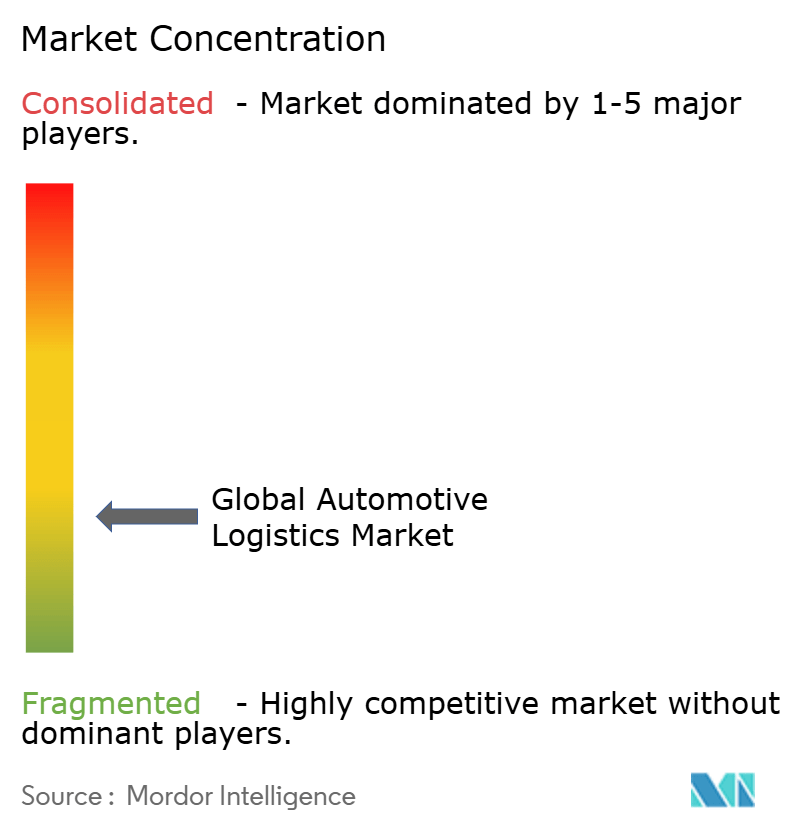
Global Automotive Logistics Market News
- March 2024: Al-Futtaim Logistics won the Game-Changer in Finished Vehicle Logistics Award 2024 at the recently held TLME Game-Changers Awards 2024, in March 2024. Held in Dubai and presented by well-known TV personality Katie Jensen, the Game-Changers Awards saw a host of talent from the Middle East and the Global transport and logistics industry in attendance. Al-Futtaim Logistics is on a journey of innovation, automation, and digital transformation making use of intelligent technologies to improve speed, reliability, safety, and cost-effectiveness. Using IoT-based yard management techniques involving ultra-wide-band technology, data analytics, and connected vehicles, Al-Futtaim has taken finished vehicle logistics to the next level of innovation and efficiency.This award recognizes and celebrates Al-Futtaim Logistics' expertise and wide-ranging experience in the highly competitive and sophisticated automotive logistics industry
- January 2024: Mahindra Logistics Limited announced the construction of its warehousing facility in Phaltan, near Pune with an investment of INR 170 crore (USD 20.54 million). Spread over 6.5 lakh square feet (sq ft), the new facility will be developed in two phases. The first phase, comprising 3.5 lakh sq ft, is scheduled to be operational by the end of 2024, the company said in a statement. Mahindra Logistics will manage inbound logistics to manufacturing and distribution solutions of diverse clients in automotive and manufacturing sectors located in the region.
Global Automotive Logistics Market Report - Table of Contents
1. INTRODUCTION
- 1.1 Study Deliverables
- 1.2 Study Assumptions
- 1.3 Scope of the Study
2. RESEARCH METHODOLOGY
- 2.1 Analysis Methodology
- 2.2 Research Phases
3. EXECUTIVE SUMMARY
4. MARKET INSIGHTS
- 4.1 Current Market Scenario
- 4.2 Industry Value Chain Analysis
- 4.3 Government Regulations and Initiatives
- 4.4 Global Logistics Sector (Overview, LPI Scores, Key Freight Statistics, etc.)
- 4.5 Focus on the Global Automotive Industry (Overview, Development and Trends, Statistics, etc.)
- 4.6 Spotlight - Effect of E-commerce on Traditional Automotive Logistics Supply Chain
- 4.7 Review and Commentary on Reverse Logistics (Overview, Challenges in Comparison with Forwards Logistics, etc.)
- 4.8 Insights on Automotive Aftermarket and its Logistics Activities
- 4.9 Spotlight on the Demand for Contract Logistics and Integrated Logistics
- 4.10 Impact of Geopolitics and Pandemic on the Market
5. MARKET DYNAMICS
-
5.1 Market Drivers
- 5.1.1 Increased Vehicle Production and Sales
- 5.1.2 E-commerce and Omnichannel Distribution
-
5.2 Market Restraints
- 5.2.1 Supply Chain Disruptions
- 5.2.2 Infrastructure Limitations
-
5.3 Market Opportunities
- 5.3.1 Technological Innovations
- 5.3.2 Investing in Sustainability Initiatives
-
5.4 Industry Attractiveness - Porter's Five Forces Analysis
- 5.4.1 Bargaining Powers of Buyers/Consumers
- 5.4.2 Bargaining Power of Suppliers
- 5.4.3 Threat of New Entrants
- 5.4.4 Threat of Substitute Products
- 5.4.5 Intensity of Competitive Rivalry
6. MARKET SEGMENTATION
-
6.1 By Service
- 6.1.1 Transportation
- 6.1.2 Warehousing, Distribution, and Inventory Management
- 6.1.3 Other Services
-
6.2 By Type
- 6.2.1 Finished Vehicle
- 6.2.2 Auto Components
- 6.2.3 Other Types
-
6.3 Geography
- 6.3.1 Asia-Pacific
- 6.3.1.1 China
- 6.3.1.2 Japan
- 6.3.1.3 India
- 6.3.1.4 South Korea
- 6.3.1.5 Rest of Asia-Pacific
- 6.3.2 North America
- 6.3.2.1 United States
- 6.3.2.2 Canada
- 6.3.2.3 Mexico
- 6.3.3 Europe
- 6.3.3.1 United Kingdom
- 6.3.3.2 Germany
- 6.3.3.3 Italy
- 6.3.3.4 Russia
- 6.3.3.5 France
- 6.3.3.6 Rest of Europe
- 6.3.4 Latin America
- 6.3.4.1 Brazil
- 6.3.4.2 Argentina
- 6.3.4.3 Rest of Latin America
- 6.3.5 Middle East & Africa
- 6.3.5.1 South Africa
- 6.3.5.2 United Arab Emirates
- 6.3.5.3 Saudi Arabia
- 6.3.5.4 Rest of Middle East & Africa
7. COMPETITIVE LANDSCAPE
- 7.1 Overview (Market Concentration and Major Players)
-
7.2 Company Profiles
- 7.2.1 Hellmann Worldwide Logistics SE & Co. KG
- 7.2.2 APL Logistics Ltd
- 7.2.3 BLG Logistics Group AG & Co. KG
- 7.2.4 CEVA Logistics
- 7.2.5 DB Schenker
- 7.2.6 DHL Group
- 7.2.7 GEFCO SA
- 7.2.8 Kerry Logistics Network Ltd
- 7.2.9 Kuehne + Nagel International AG
- 7.2.10 Penske Logistics Inc.
- 7.2.11 Ryder System Inc.
- 7.2.12 DSV Panalpina AS
- 7.2.13 Expeditors
- 7.2.14 Panalpina
- 7.2.15 XPO Logistics Inc.
- 7.2.16 Tiba Group
- 7.2.17 Bollore Logistics
- 7.2.18 CFR Rinkens*
- *List Not Exhaustive
- 7.3 Other Companies
8. FUTURE OF THE MARKET
9. APPENDIX
- 9.1 GDP Distribution (by Activity - Key Countries)
- 9.2 Insights on Capital Flows - Key Countries
- 9.3 Economic Statistics - Transport and Storage Sector, Contribution to Economy (Key Countries)
- 9.4 Global Automotive Industry Statistics
Global Automotive Logistics Industry Segmentation
Automotive logistics refers to the comprehensive management and coordination of the transportation, warehousing, and distribution of automotive parts, components, and finished vehicles throughout the supply chain. This sector is crucial for ensuring that automotive manufacturers, suppliers, and distributors operate efficiently and meet consumer demands.
The global automotive logistics market is segmented by service (transportation, warehousing, distribution & inventory management, and other services), by type (finished vehicle, auto components, and other types), and by geography (Asia-Pacific, North America, Europe, Latin America, and the Middle East and Africa). The report offers market size and forecasts in value (USD) for all the above segments.
| By Service | Transportation | ||
| Warehousing, Distribution, and Inventory Management | |||
| Other Services | |||
| By Type | Finished Vehicle | ||
| Auto Components | |||
| Other Types | |||
| Geography | Asia-Pacific | China | |
| Japan | |||
| India | |||
| South Korea | |||
| Rest of Asia-Pacific | |||
| North America | United States | ||
| Canada | |||
| Mexico | |||
| Europe | United Kingdom | ||
| Germany | |||
| Italy | |||
| Russia | |||
| France | |||
| Rest of Europe | |||
| Latin America | Brazil | ||
| Argentina | |||
| Rest of Latin America | |||
| Middle East & Africa | South Africa | ||
| United Arab Emirates | |||
| Saudi Arabia | |||
| Rest of Middle East & Africa | |||
Global Automotive Logistics Market Research FAQs
How big is the Global Automotive Logistics Market?
The Global Automotive Logistics Market size is expected to reach USD 336.89 billion in 2025 and grow at a CAGR of 6.65% to reach USD 464.83 billion by 2030.
What is the current Global Automotive Logistics Market size?
In 2025, the Global Automotive Logistics Market size is expected to reach USD 336.89 billion.
Who are the key players in Global Automotive Logistics Market?
Hellmann Worldwide Logistics SE & Co. KG, APL Logistics Ltd, BLG Logistics Group AG & Co. KG, CEVA Logistics and DB Schenker are the major companies operating in the Global Automotive Logistics Market.
Which is the fastest growing region in Global Automotive Logistics Market?
Asia-Pacific is estimated to grow at the highest CAGR over the forecast period (2025-2030).
Which region has the biggest share in Global Automotive Logistics Market?
In 2025, the Asia-Pacific accounts for the largest market share in Global Automotive Logistics Market.
What years does this Global Automotive Logistics Market cover, and what was the market size in 2024?
In 2024, the Global Automotive Logistics Market size was estimated at USD 314.49 billion. The report covers the Global Automotive Logistics Market historical market size for years: 2019, 2020, 2021, 2022, 2023 and 2024. The report also forecasts the Global Automotive Logistics Market size for years: 2025, 2026, 2027, 2028, 2029 and 2030.
Our Best Selling Reports
Global Automotive Logistics Market Research
Mordor Intelligence provides a comprehensive analysis of the global automotive logistics industry. With decades of expertise in automotive logistics market research, we offer extensive coverage of automotive logistics companies, automotive warehousing operations, and vehicle logistics services. This report delivers detailed insights into industry dynamics. It examines automotive supply chain challenges and analyzes international automotive logistics trends along with automotive logistics solutions across major regions.
Stakeholders in the automotive logistics sector will benefit from our detailed analysis of logistics automotive management practices and emerging technologies. The report, available as an easy-to-download PDF, provides valuable insights for automotive logistics providers and vehicle logistics companies aiming to optimize their operations. Our research covers developments in automotive logistics and supply chain, trends in regional automotive warehousing, and logistics solutions for automotive industry. This enables informed decision-making for industry participants, from automobile transportation companies to automotive logistics suppliers.




